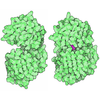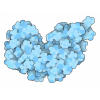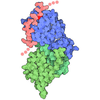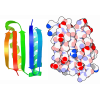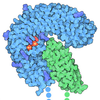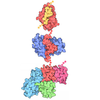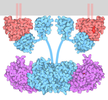+ Open data
Open data
- Basic information
Basic information
| Entry | Database: PDB / ID: 8ubt | ||||||
|---|---|---|---|---|---|---|---|
| Title | Structure of SCF-FBXL17-BACH1BTB E3 ligase complex | ||||||
 Components Components |
| ||||||
 Keywords Keywords | LIGASE / SCF / FBXL17 / BACH1 / F-box protein / E3 ligase | ||||||
| Function / homology |  Function and homology information Function and homology informationRegulation of HMOX1 expression and activity / Parkin-FBXW7-Cul1 ubiquitin ligase complex / F-box domain binding / PcG protein complex / ligand-modulated transcription factor activity / cullin-RING ubiquitin ligase complex / positive regulation of ubiquitin protein ligase activity / Cul7-RING ubiquitin ligase complex / maintenance of protein location in nucleus / Loss of Function of FBXW7 in Cancer and NOTCH1 Signaling ...Regulation of HMOX1 expression and activity / Parkin-FBXW7-Cul1 ubiquitin ligase complex / F-box domain binding / PcG protein complex / ligand-modulated transcription factor activity / cullin-RING ubiquitin ligase complex / positive regulation of ubiquitin protein ligase activity / Cul7-RING ubiquitin ligase complex / maintenance of protein location in nucleus / Loss of Function of FBXW7 in Cancer and NOTCH1 Signaling / regulation of smoothened signaling pathway / neural crest cell differentiation / regulation of metabolic process / SCF ubiquitin ligase complex / NFE2L2 regulating anti-oxidant/detoxification enzymes / SCF-dependent proteasomal ubiquitin-dependent protein catabolic process / ubiquitin ligase complex scaffold activity / Prolactin receptor signaling / protein quality control for misfolded or incompletely synthesized proteins / cullin family protein binding / protein monoubiquitination / ubiquitin-like ligase-substrate adaptor activity / protein K48-linked ubiquitination / Nuclear events stimulated by ALK signaling in cancer / intrinsic apoptotic signaling pathway / Regulation of BACH1 activity / MAP3K8 (TPL2)-dependent MAPK1/3 activation / molecular function activator activity / animal organ morphogenesis / SCF-beta-TrCP mediated degradation of Emi1 / NIK-->noncanonical NF-kB signaling / Vpu mediated degradation of CD4 / Dectin-1 mediated noncanonical NF-kB signaling / Activation of NF-kappaB in B cells / Degradation of GLI1 by the proteasome / Iron uptake and transport / GSK3B and BTRC:CUL1-mediated-degradation of NFE2L2 / Heme signaling / Negative regulation of NOTCH4 signaling / G1/S transition of mitotic cell cycle / Degradation of GLI2 by the proteasome / GLI3 is processed to GLI3R by the proteasome / FBXL7 down-regulates AURKA during mitotic entry and in early mitosis / beta-catenin binding / Degradation of beta-catenin by the destruction complex / NOTCH1 Intracellular Domain Regulates Transcription / CLEC7A (Dectin-1) signaling / SCF(Skp2)-mediated degradation of p27/p21 / DNA-binding transcription repressor activity, RNA polymerase II-specific / Constitutive Signaling by NOTCH1 PEST Domain Mutants / Constitutive Signaling by NOTCH1 HD+PEST Domain Mutants / RNA polymerase II transcription regulator complex / FCERI mediated NF-kB activation / Interleukin-1 signaling / Orc1 removal from chromatin / protein polyubiquitination / Regulation of RUNX2 expression and activity / Cyclin D associated events in G1 / : / Regulation of PLK1 Activity at G2/M Transition / Antigen processing: Ubiquitination & Proteasome degradation / Downstream TCR signaling / nervous system development / Neddylation / DNA-binding transcription activator activity, RNA polymerase II-specific / protein-macromolecule adaptor activity / proteasome-mediated ubiquitin-dependent protein catabolic process / DNA-binding transcription factor activity, RNA polymerase II-specific / positive regulation of canonical NF-kappaB signal transduction / cell population proliferation / protein ubiquitination / chromatin remodeling / RNA polymerase II cis-regulatory region sequence-specific DNA binding / DNA-binding transcription factor activity / protein domain specific binding / DNA repair / heme binding / centrosome / ubiquitin protein ligase binding / regulation of DNA-templated transcription / regulation of transcription by RNA polymerase II / chromatin / negative regulation of transcription by RNA polymerase II / nucleoplasm / nucleus / plasma membrane / cytosol / cytoplasm Similarity search - Function | ||||||
| Biological species |  Homo sapiens (human) Homo sapiens (human) | ||||||
| Method | ELECTRON MICROSCOPY / single particle reconstruction / cryo EM / Resolution: 3.1 Å | ||||||
 Authors Authors | Shi, H. / Cao, S. | ||||||
| Funding support |  United States, 1items United States, 1items
| ||||||
 Citation Citation |  Journal: Cell / Year: 2024 Journal: Cell / Year: 2024Title: Recognition of BACH1 quaternary structure degrons by two F-box proteins under oxidative stress. Authors: Shiyun Cao / Sheena Faye Garcia / Huigang Shi / Ellie I James / Yuki Kito / Hui Shi / Haibin Mao / Sharon Kaisari / Gergely Rona / Sophia Deng / Hailey V Goldberg / Jackeline Ponce / Beatrix ...Authors: Shiyun Cao / Sheena Faye Garcia / Huigang Shi / Ellie I James / Yuki Kito / Hui Shi / Haibin Mao / Sharon Kaisari / Gergely Rona / Sophia Deng / Hailey V Goldberg / Jackeline Ponce / Beatrix Ueberheide / Luca Lignitto / Miklos Guttman / Michele Pagano / Ning Zheng /    Abstract: Ubiquitin-dependent proteolysis regulates diverse cellular functions with high substrate specificity, which hinges on the ability of ubiquitin E3 ligases to decode the targets' degradation signals, i. ...Ubiquitin-dependent proteolysis regulates diverse cellular functions with high substrate specificity, which hinges on the ability of ubiquitin E3 ligases to decode the targets' degradation signals, i.e., degrons. Here, we show that BACH1, a transcription repressor of antioxidant response genes, features two distinct unconventional degrons encrypted in the quaternary structure of its homodimeric BTB domain. These two degrons are both functionalized by oxidative stress and are deciphered by two complementary E3s. FBXO22 recognizes a degron constructed by the BACH1 BTB domain dimer interface, which is unmasked from transcriptional co-repressors after oxidative stress releases BACH1 from chromatin. When this degron is impaired by oxidation, a second BACH1 degron manifested by its destabilized BTB dimer is probed by a pair of FBXL17 proteins that remodels the substrate into E3-bound monomers for ubiquitination. Our findings highlight the multidimensionality of protein degradation signals and the functional complementarity of different ubiquitin ligases targeting the same substrate. | ||||||
| History |
|
- Structure visualization
Structure visualization
| Structure viewer | Molecule:  Molmil Molmil Jmol/JSmol Jmol/JSmol |
|---|
- Downloads & links
Downloads & links
- Download
Download
| PDBx/mmCIF format |  8ubt.cif.gz 8ubt.cif.gz | 234.3 KB | Display |  PDBx/mmCIF format PDBx/mmCIF format |
|---|---|---|---|---|
| PDB format |  pdb8ubt.ent.gz pdb8ubt.ent.gz | 178.1 KB | Display |  PDB format PDB format |
| PDBx/mmJSON format |  8ubt.json.gz 8ubt.json.gz | Tree view |  PDBx/mmJSON format PDBx/mmJSON format | |
| Others |  Other downloads Other downloads |
-Validation report
| Summary document |  8ubt_validation.pdf.gz 8ubt_validation.pdf.gz | 1.2 MB | Display |  wwPDB validaton report wwPDB validaton report |
|---|---|---|---|---|
| Full document |  8ubt_full_validation.pdf.gz 8ubt_full_validation.pdf.gz | 1.3 MB | Display | |
| Data in XML |  8ubt_validation.xml.gz 8ubt_validation.xml.gz | 41 KB | Display | |
| Data in CIF |  8ubt_validation.cif.gz 8ubt_validation.cif.gz | 59.9 KB | Display | |
| Arichive directory |  https://data.pdbj.org/pub/pdb/validation_reports/ub/8ubt https://data.pdbj.org/pub/pdb/validation_reports/ub/8ubt ftp://data.pdbj.org/pub/pdb/validation_reports/ub/8ubt ftp://data.pdbj.org/pub/pdb/validation_reports/ub/8ubt | HTTPS FTP |
-Related structure data
| Related structure data |  42102MC  8ua3C  8ua6C  8uahC  8ubuC  8ubvC M: map data used to model this data C: citing same article ( |
|---|---|
| Similar structure data | Similarity search - Function & homology  F&H Search F&H Search |
- Links
Links
- Assembly
Assembly
| Deposited unit | 
|
|---|---|
| 1 |
|
- Components
Components
| #1: Protein | Mass: 88501.945 Da / Num. of mol.: 1 / Fragment: UNP residues 310-701 Source method: isolated from a genetically manipulated source Source: (gene. exp.)  Homo sapiens (human) / Gene: CUL1 / Cell line (production host): High Five / Production host: Homo sapiens (human) / Gene: CUL1 / Cell line (production host): High Five / Production host:  Trichoplusia ni (cabbage looper) / References: UniProt: Q13616 Trichoplusia ni (cabbage looper) / References: UniProt: Q13616 |
|---|---|
| #2: Protein | Mass: 18679.965 Da / Num. of mol.: 1 / Fragment: BTB domain (UNP residues 7-128) Source method: isolated from a genetically manipulated source Source: (gene. exp.)  Homo sapiens (human) / Gene: SKP1, EMC19, OCP2, SKP1A, TCEB1L / Production host: Homo sapiens (human) / Gene: SKP1, EMC19, OCP2, SKP1A, TCEB1L / Production host:  |
| #3: Protein | Mass: 44505.512 Da / Num. of mol.: 1 / Fragment: UNP residues 310-701 Source method: isolated from a genetically manipulated source Source: (gene. exp.)  Homo sapiens (human) / Gene: FBXL17 / Cell line (production host): High Five / Production host: Homo sapiens (human) / Gene: FBXL17 / Cell line (production host): High Five / Production host:  Trichoplusia ni (cabbage looper) / References: UniProt: Q9UF56 Trichoplusia ni (cabbage looper) / References: UniProt: Q9UF56 |
| #4: Protein | Mass: 13839.761 Da / Num. of mol.: 1 / Fragment: BTB domain (UNP residues 7-128) Source method: isolated from a genetically manipulated source Source: (gene. exp.)  Homo sapiens (human) / Gene: BACH1 / Production host: Homo sapiens (human) / Gene: BACH1 / Production host:  |
| Has protein modification | Y |
-Experimental details
-Experiment
| Experiment | Method: ELECTRON MICROSCOPY |
|---|---|
| EM experiment | Aggregation state: PARTICLE / 3D reconstruction method: single particle reconstruction |
- Sample preparation
Sample preparation
| Component | Name: The SCF-F-box protein with BACH1 BTB Domain, SCF-BFXL17-BACH1BTB Type: COMPLEX / Entity ID: all / Source: RECOMBINANT |
|---|---|
| Source (natural) | Organism:  Homo sapiens (human) Homo sapiens (human) |
| Source (recombinant) | Organism:  Trichoplusia ni (cabbage looper) Trichoplusia ni (cabbage looper) |
| Buffer solution | pH: 7.5 |
| Specimen | Embedding applied: NO / Shadowing applied: NO / Staining applied: NO / Vitrification applied: YES |
| Specimen support | Grid material: COPPER / Grid mesh size: 300 divisions/in. / Grid type: Quantifoil R1.2/1.3 |
| Vitrification | Instrument: FEI VITROBOT MARK IV / Cryogen name: ETHANE |
- Electron microscopy imaging
Electron microscopy imaging
| Experimental equipment |  Model: Titan Krios / Image courtesy: FEI Company |
|---|---|
| Microscopy | Model: TFS KRIOS |
| Electron gun | Electron source:  FIELD EMISSION GUN / Accelerating voltage: 300 kV / Illumination mode: FLOOD BEAM FIELD EMISSION GUN / Accelerating voltage: 300 kV / Illumination mode: FLOOD BEAM |
| Electron lens | Mode: BRIGHT FIELD / Nominal defocus max: 25000 nm / Nominal defocus min: 5000 nm / Alignment procedure: COMA FREE |
| Specimen holder | Cryogen: NITROGEN / Specimen holder model: FEI TITAN KRIOS AUTOGRID HOLDER |
| Image recording | Electron dose: 60 e/Å2 / Film or detector model: FEI FALCON IV (4k x 4k) |
- Processing
Processing
| Software | Name: PHENIX / Version: 1.20.1_4487: / Classification: refinement | ||||||||||||||||||||||||
|---|---|---|---|---|---|---|---|---|---|---|---|---|---|---|---|---|---|---|---|---|---|---|---|---|---|
| EM software |
| ||||||||||||||||||||||||
| CTF correction | Type: PHASE FLIPPING AND AMPLITUDE CORRECTION | ||||||||||||||||||||||||
| Symmetry | Point symmetry: C1 (asymmetric) | ||||||||||||||||||||||||
| 3D reconstruction | Resolution: 3.1 Å / Resolution method: FSC 0.143 CUT-OFF / Num. of particles: 364786 / Algorithm: BACK PROJECTION / Symmetry type: POINT | ||||||||||||||||||||||||
| Atomic model building | Protocol: RIGID BODY FIT / Space: REAL | ||||||||||||||||||||||||
| Atomic model building |
| ||||||||||||||||||||||||
| Refine LS restraints |
|
 Movie
Movie Controller
Controller









 PDBj
PDBj

